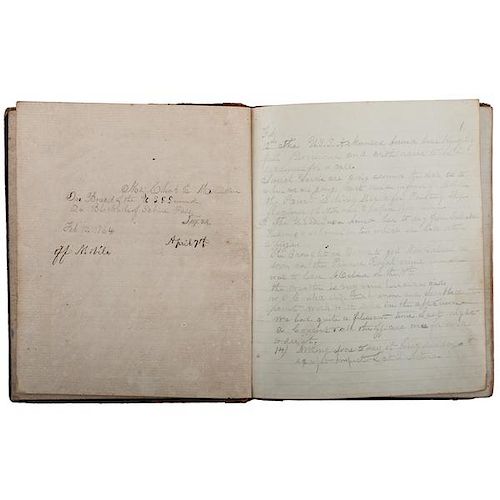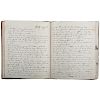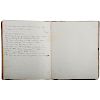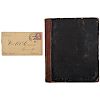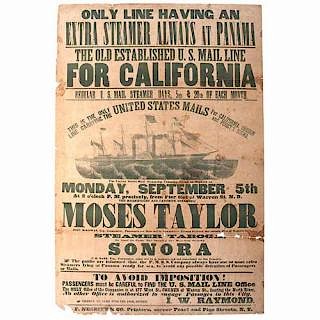Civil War Diary of Charles E. Milliken, Aboard USS Seminole, Killed Disarming a Bomb at the Battle of Mobile Bay
About Seller
6270 Este Ave.
Cincinnati , OH 45232
United States
With offices in Cincinnati, Cleveland and Denver, Cowan’s holds over 40 auctions each year, with annual sales exceeding $16M. We reach buyers around the globe, and take pride in our reputation for integrity, customer service and great results. A full-service house, Cowan’s Auctions specializes in Am...Read more
Two ways to bid:
- Leave a max absentee bid and the platform will bid on your behalf up to your maximum bid during the live auction.
- Bid live during the auction and your bids will be submitted real-time to the auctioneer.
Bid Increments
| Price | Bid Increment |
|---|---|
| $0 | $25 |
| $500 | $50 |
| $1,000 | $100 |
| $2,000 | $250 |
| $5,000 | $500 |
| $10,000 | $1,000 |
| $20,000 | $2,500 |
| $50,000 | $5,000 |
| $100,000 | $10,000 |
About Auction
Jun 10, 2016 - Jun 11, 2016
Cowan's Auctions dawnie@cowans.com
- Lot Description
Civil War Diary of Charles E. Milliken, Aboard USS Seminole, Killed Disarming a Bomb at the Battle of Mobile Bay
Diary of Charles E. Milliken, 7 x 8.5 in., with brown leather spine and black boards, 85pp of text, dated Feb. 12, 1864 to August 24, 1864 (his death). Front pastedown penciled with the names of enemy ships important to the USS Seminole, including its prizes, the blockade runners Charleston and William Peel, and the CSS Tennessee, from which it took many of the crew prisoner after its capture.
First page inscribed Mr. Chas. E. Milliken / On Board of the USS Seminole On Blockade of Sabine Pass, Texas / Feb. 12, 1864, corresponding to the date of the first entry. There are entries for every day until August 24, most with 4-12 lines of text describing the weather, the day’s work, ship movements, ship sightings, and war news and rumors among the crew.
On April 7 the Seminole arrived off Mobile and Milliken noted the sight of Mobile and its significant ships. In the spring and summer before the battle he reports on the arrival of new ships and conglomeration of the fleet, captured blockade runners, and several Union Navy sailors brought aboard the Seminole and put in irons for desertion.
There was a minor standoff on May 20, “...the flagship (Richmond) fire guns and made signals to the fleet that the Rebel ram’s were over the bar and expected an attack tonight. We discharged all of our small arms and reloaded again. Called all hands to muster and the Captain told us that we had but once to die and he wanted us to stand bravely at our posts and the Rebels would never take us as the ship would be blown up before he should surrender. He told us our motto was “Victors or Death, Seminole Forever.” The following day’s entry says that the rams never did make an appearance, but Admiral Farragut did arrive on the USS Hartford.
On July 4th they dressed the ship for the holiday then received orders from the Hartford to attack the enemy’s vessels, resulting in taking return fire from the fort including a hit in the side just below the waterline.
When the Battle of Mobile Bay becomes imminent in late July, Milliken notes the arrival of many ships from New Orleans and elsewhere; on August 3rd notes steady fire through the night; and on August 4th the Seminole took on coal and sand bags in preparation for the attack the next morning. All hands were called to deck at 4am and given breakfast and the anchor was lifted at 5. Seminole went alongside Lackawanna before joining the Hartford to get underway, being the 4th pair in line. He describes the order and sequence of battle and notes that once the action became full-blown: The Lackawanna received a shot which killed ½ a gun’s crew and threw splinters over us. The Ram Tennessee then steamed out for the Hartford but missing her the Hartford then put in a good broadside into her but taking no effect. She then made for us but we were too fast for her. She then went back to the fort. During the engagement the Tecumseh was sunk by a torpedo.
After watching Metacomet take a vessel attempting to skedaddle, the crew gave three cheers for victory and anchored but no sooner did the Tennessee come back for them. The Tennessee sent a large ball over the deck of the Seminole but the Rebel vessel soon found itself surrounded and taking fire from multiple directions, described in detail by the writer. Eventually the Union crew forced her to hoist the flag of surrender, and after taking on prisoners from her and the Selma, Milliken himself boarded the Tennessee: I went aboard the ram and I never saw such a sight in my life. She was never misrepresented as to her strength. She carries 6 Brook’s 120lb rifles, her iron is 8 or 9 inches of solid iron with cotton and wood of about 3 foot thickness.
Provenance: The M. Clifford (Cliff) and Lynne B. Young Confederate Blockade Runner Collection - Shipping Info
-
SHIPPING. At the request of the buyer, Cowan's will authorize the shipment of purchased items. Shipments usually occur within two weeks after payment has been received. Shipment is generally made via UPS Ground service. Unless buyer gives special instructions, the shipping method shall be at the sole discretion of Cowan's Auctions, Inc.. Cowan's is in no way responsible for the acts or omissions of independent handlers, packers or shippers of purchased items or for any loss, damage or delay from the packing or shipping of any property.
-
- Buyer's Premium



 EUR
EUR CAD
CAD AUD
AUD GBP
GBP MXN
MXN HKD
HKD CNY
CNY MYR
MYR SEK
SEK SGD
SGD CHF
CHF THB
THB